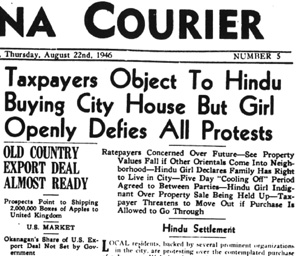





|

|
The 1940s were indeed a boom time for the Sikhs living in BC. Jobs were plentiful because of the wartime economy and the
shortage of labor at the mills and elsewhere. Because the Sikhs did not have to go to war and had a solid reputation as good
reliable laborers, their services were in demand. Everyone had a good job. Sikhs’ businesses flourished as they took over
lucrative contracts, their trucking businesses prospered, and their traditional investments in real estate grew. The community
prospered economically through hard work, extensive social networking and better employment opportunities, and the Sikhs
had become established by investing in their businesses, farms, homes and properties. Their numbers were growing slowly and
becoming more balanced in terms of age and gender.
However, this newfound prosperity did little to change their standing as
Canadians. They still could not call Canada their home until they gained the franchise. Throughout the Sikhs’ years in Canada
but especially after World War Two, much of the community’s time and energy was focused on gaining the franchise. They had
waited long enough. Much of what the Sikhs wanted and needed now was tied to their right to vote. So this one issue
dominated all others and became the Sikh community’s major goal. The leaders of this campaign were Naginder Singh Gill,

|
|
Media Coverage of racial discrimination against the Singh family in Kelowna, 1946
|
Kapoor Singh, Mayo Singh, Kartar Singh and Dr. D. P. Pandia. They sent correspondence to Ottawa, and sent delegations
there to meet with government officials and explain their special situation. Dr. Pandia, a Hindu lawyer who came to Canada in
1939, led a delegation that included Mr. Batan Singh Dhoot from Victoria, Mr. Ishar Singh Bains and Mr. Naina Singh
Kondola. Batan Singh Dhoot financed this campaign, giving $25,000 initially and several thousands thereafter.
While many important campaigns for social and political justice were organized by the whole Sikh community, there were also
significant individual victories for social and political justice.
In 1946, Mrs. Ajit Kaur Singh took on an entire city and won. Her father, Mehar Singh, had come to Canada in 1907. He had

|
The Singh family on their farms in Kelowna, 1937.
Left to Right: Ajit Kaur Singh, Kartar, Harbhajan, Beant Kaur, Jeet and thier dog
Lenny.
|
worked as the foreman of the Sikh workers on the Canadian Pacific Railway and later as a bookkeeper at Mayo’s Mill. In
1929, his wife Naranjan and daughter Ajit arrived from India and settled with him on their twenty-acre orchard in Kelowna.
They worked hard and prospered, and the family grew to six children. In 1942, Mehar Singh died. Ajit and her mother raised
the family and kept the farm going through these difficult times. In 1946 they decided to sell the farm and buy a house in the city
where life would be easier and the children could go to better schools. They purchased a nice home in Kelowna for $6000,and
were stopped from moving in because some residents did not want " hindoos " in their neighborhood.

|
|
In 1987, Ajit Kaur Singh and her two grandchildren, Michael and Jhan
|
The matter went to city council. Ajit and a supportive neighbor - Captain Bull, a retired British army officer and a former
member of the BC Legislature -spoke in front of the councillors. It was a simple case of racial discrimination, there could be no
denial of that. The incident generated considerable public controversy, and the 2nd Avenue temple committee kept an eye on
the situation. Eventually Ajit’s courage and persistence paid off. After weeks of heated debate and fear of political fallout, she
and her family were allowed to move into their home. They became model citizens and many of their previously angry neighbors
became their admirers.
|
cont...
[p.2]









|










